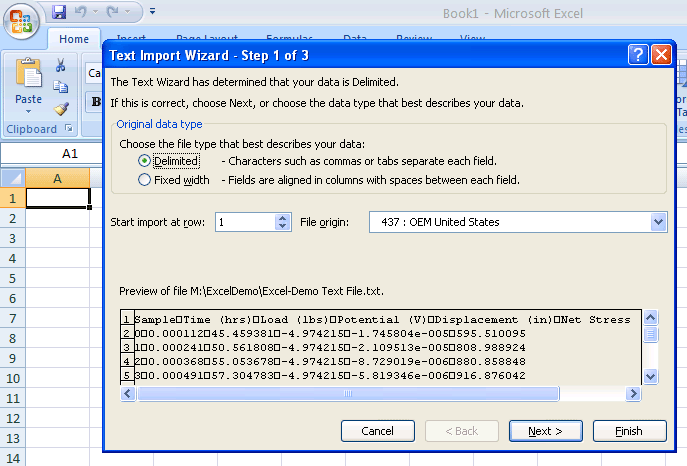
The importing/exporting function is in Outlook. I would like to automate this process with macros, ideally run from Excel. I am importing/exporting calendar data between my Outlook calendar and an Excel (.csv) file. If somebody has a suggestion, it would be highly appreciated! Then nothing happens, nor error message nor data imported.
#Excel text import wizard delimeter how to#
How to load it during the import process.Ģ- If I simply press Ok, a second window appears with the legend "PleaseĮnter MS JET OLE DB Initialization Information", I leave the fields with theĭefault data (the field "Provider String" is blank by defult) and press Ok,

The workgroup information file is missing or openedĮxlucsively by another user." Well, I have a workgroup file, but don't know mdb I want to import data from, and I fill theįields user name and password, this happen with two different scenarios:ġ- If the test connection button is pressed, the error message is "TestĬonnection failed because of an error in initializing provider. I am following these steps in excel: Data - Import External Data - Importĭata.
#Excel text import wizard delimeter password#
I have a user level password protected Accessĭatabase and an Excel spreadsheet in which I need to load a query from the DB. That’s nice, because what if I had selected a cell that contained data I didn’t want to overwrite? Anyway, I’m in blank cell in a new worksheet, so I’ll accept Existing Worksheet and cell =$A$1, and click OK.Īnd here’s my imported data! As a plus, the Text Import Wizard (in most cases) optimizes the width of the columns to fit the data so you don’t have to.Hi!, this is my situation. Now, Excel asks me if I want to import the data right here in the current cell or create a new worksheet. But all of these columns look fine, so I’ll click Finish. I can select each column and, if I want, change its data type so that it has a format I prefer or a right or left margin. I’ll click Next to go to the third and last step of the wizard. There, see how the preview changes and looks right now? Notice how, with the tab character as the delimiter, the preview doesn’t look right? So I see I need to change that from Tab to Comma. The default delimiting character in Excel is the tab character, so it’s pre-selected here in step 2.

My data certainly is delimited by those commas, so I’ll click Next. Notice how the Delimited button is already selected? Now, click the Data tab, and in the Get External Data group, click From Text. To import the contents of the file, select an empty cell in Excel - this can be in a new workbook, a new worksheet in an existing workbook, or in an existing worksheet. The rows of information look just like this in the text file: The first row of the file is the column names, which are also separated by commas. In this file, the four pieces of information for each employee are separated (also known as “delimited”) by a comma. Of course, you’re allowed to fine tune or override these suggestions so that the data comes into Excel just the way you want. You point Excel’s Text Import Wizard to a file, and the wizard leads you through a few steps where it looks at the rows of data in the source file and makes suggestions based on the layout of the file. When you use the Text Import Wizard, you don’t open your data source in its native program. Importing! Yes, importing is not just for purveyors of fine art or exotic foods. Luckily for you, there’s a much better way to get that data into Excel. And copying from another program or from the web and pasting directly into a cell in a workbook might leave you with nightmarish looking results I’ve seen this, believe me. Whatever the case, I can guarantee you the last thing you’d ever want to do is retype it, so that option is out unless you really love typing and have tons of extra time on your hands. Where does this data come from? It might come from a database or some other program, or even the web. If you’ve worked with Excel long enough, you’ve probably needed to get data into Excel so that you can analyze it, or maybe create a chart.


 0 kommentar(er)
0 kommentar(er)
